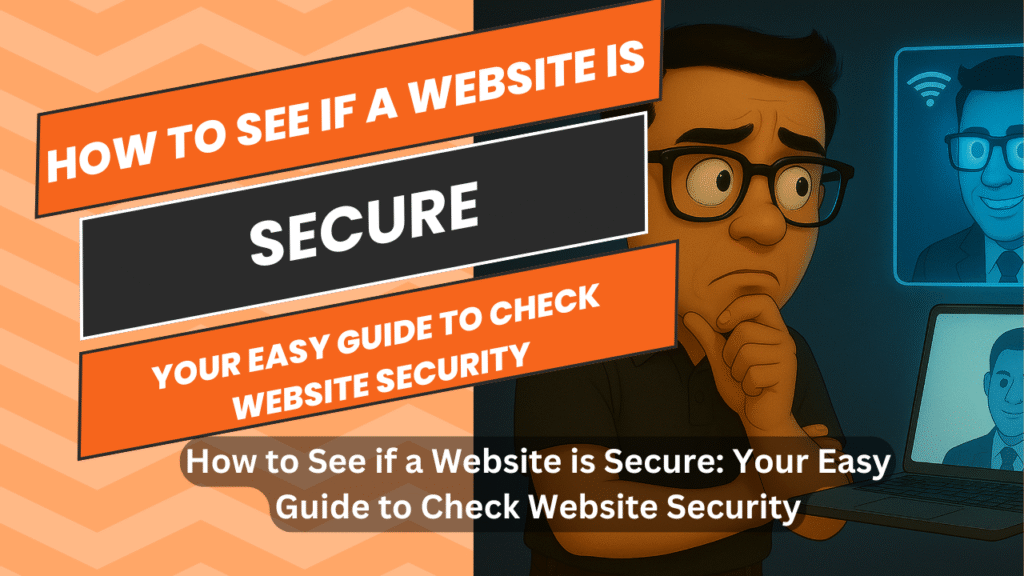How to See if a Website is Secure: Your Easy Guide to Check Website Security
The internet is a big part of modern life. Yet, convenience always comes with some risks. Knowing how to see if a website is secure online is vital for keeping your personal details safe. It protects your financial data and overall online security. This guide gives you the facts and steps to confidently browse the web.
Bad actors, from phishing scams to malware, constantly change their tricks. Knowing what to look for can stop you from being a victim. This article breaks down key signs of website security and shows you how to check if a website is safe to buy from. It makes it easy for anyone to check a site’s trustworthiness before typing in sensitive information.
1. The Foundation: Understanding HTTPS and SSL/TLS Certificates
What is HTTPS and Why It Matters
HTTP and HTTPS are two ways websites send data. Think of HTTP as sending a postcard—anyone can read your message as it travels. HTTPS is like putting your message in a sealed, encrypted envelope. It scrambles the data between your browser and the website’s server. This makes the information unreadable to anyone trying to snoop. Seeing “https://” in the web address is the most basic sign of a secure connection. If you’re wondering how to see if a website is secure free, this is the first thing to check.
Recognizing the Padlock Icon
A small padlock icon often shows up in your browser’s address bar. This visual cue means a site uses HTTPS. Clicking on this padlock usually shows you details about the website’s security certificate. Browsers like Chrome and Firefox will display this padlock. Some browsers might also show a clear warning if a site’s certificate is not valid. It’s a quick way to start a website trust check.
Verifying the SSL/TLS Certificate Details
The padlock lets you check the certificate. You can see its validity period and the name of the organization it was issued to. Extended Validation (EV) certificates offer a higher level of trust—they often display the company’s verified name right in the address bar. If you’re doing a website security check online free, this is one of the easiest and most accessible methods. Always check certificate details before entering payment or login info.
2. Beyond the Padlock: Website Design and Content Clues
Professional Website Design and Branding
Real businesses usually put effort into their website design. Look for a clean, easy-to-use layout. Websites that look thrown together, have bad grammar, or many spelling errors are potential warning signs. Be cautious of sites that seem hastily built or lack a consistent brand look. These signs are part of any thorough website trust check.
Contact Information and Transparency
Trustworthy websites make it easy to find their contact details. This includes a physical address, phone number, and email. Transparent companies are usually more honest. Reputable online stores often show “About Us” and “Contact” pages clearly. These pages help you evaluate how to check if a website is safe to buy from.
Website Reviews and Reputation
Checking a website’s reputation is smart. Look for reviews on other sites or simply search online. Type “[website name] reviews” or “[website name] scam” into a search engine. This helps you see what others say about the site. It’s also a helpful step in any website safety check Google process.
3. Identifying Phishing and Malware Attempts
Decoding Suspicious URLs and Domain Names
Phishing attempts often use web addresses that look very similar to real ones. They might have a tiny spelling mistake or use a different, strange ending like “.biz” instead of “.com.” Always check the domain name in the URL bar very carefully for any oddities. This careful check is a must for any website safety check Google users should practice.
Unexpected Pop-ups and Download Prompts
Malicious websites often hit you with many annoying pop-up ads. They might also try to make you download files you didn’t ask for. If you see aggressive pop-ups, close them using the ‘X’ button. Never download anything from a website you don’t fully trust.
Requests for Unnecessary Personal Information
Legitimate websites typically only ask for the information they need. Be wary if a website asks for your social security number, full bank account details, or passwords just to browse. Always be cautious, especially when you’re trying to figure out how to see if a website is secure online.
4. Leveraging Security Tools and Browser Features
Using Browser Security Warnings
Modern web browsers have built-in safety features. They often warn you about sites that might be unsafe. These warnings appear for known phishing sites or places with malware. Always pay attention to browser alerts and follow their advice.
Exploring Website Security Checkers
You can use website security check online free tools to scan websites for risks. These checkers analyze sites for malware, phishing indicators, and security vulnerabilities. Tools like Google Safe Browsing, Norton Safe Web, or Sucuri SiteCheck are considered among the best website safety checker options out there. They’re perfect for getting quick, detailed reports on any website you’re unsure about.
Keeping Browsers and Antivirus Software Updated
Software updates often include critical security fixes. Make sure your web browser and antivirus programs are always current to defend against new threats. Regular updates are a vital part of your personal website safety check Google strategy.
5. Recognizing the Signs of a Compromised Website
Unusual Website Behavior
A hacked or compromised site might behave strangely—redirecting you, throwing up odd error messages, or displaying unfamiliar content. If you notice anything off, treat it as a red flag.
Lack of Recent Updates or Activity
Websites that are not maintained are easier targets for hackers. Check for recent blog posts or news updates. An outdated site may signal poor security management.
Unsolicited Emails or Communications from the Website
If you start receiving spam or phishing emails after visiting a site, it could be a sign the website was unsafe or breached. That’s when using a website trust check tool retroactively can help you confirm your suspicion.
Your Role in Online Security
Protecting yourself online comes down to being alert. Knowing how to see if a website is secure free and using simple tools makes you a smarter and safer internet user. Make checking website security a regular habit—it’s your best defense.
The key signs of a safe website are:
- HTTPS: Always look for this in the URL.
- Padlock Icon: Confirm its presence and check certificate details.
- Professional Design: A well-made site builds trust.
- Clear Contact Info: Good businesses are transparent.
- URL Details: Scrutinize the domain name closely.
- Use Security Tools: Apply the best website safety checker options to stay safe.
Proactive steps like these are your strongest shield against online dangers. You now know exactly how to see if a website is secure online—and how to do it for free.

